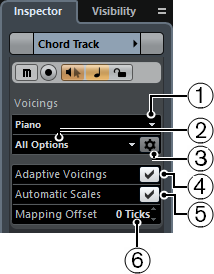Setting up Voicings
To set up voicings for the entire chord track, you can use the chord track Inspector.

Voicing library
Allows you to select Guitar, Piano, or Basic as a voicing library.
Voicing library subset
NoteThis is only available if Guitar or Piano is set as voicing library.
Allows you to select a preset voicing library subset.
Configure voicing parameters
Allows you to configure your own voicing parameters for a specific voicing scheme.
Adaptive Voicings
Activate this to let Cubase set the voicings automatically. This prevents the individual voices from jumping too much.
Automatic Scales
Activate this to let Cubase set the scales automatically.
Mapping Offset
If you enter a negative number of ticks, the chord events will affect the MIDI notes that have been triggered too early.
Configure Voicing Parameters
If you click Configure Voicing Parameters in the Voicings section of the Inspector, you can configure your own voicing parameters for a specific voicing scheme.
The Start Voicing section for piano, guitar, and basic voicings lets you select a start voicing. This is only available for MIDI, instrument, and audio tracks, but not for the chord track, and only if you select Voicings in the Follow Chord Track pop-up menu.
In the Style section for Piano voicings, you can set up the following parameters:
- Triads
Sets a triad. Chords with more than 3 notes are not changed.
- Triads with maj9
Sets a triad with a major ninth, but without root note. Chords with more than 3 notes are not changed.
- Triads with maj9 and min9
Sets a triad with a major and a minor ninth, but without root note. Chords with more than 3 notes are not changed.
- 4-note chords
Sets a 4-note chord without root note. Chords with less than 3 notes are not changed.
- 4-note chords (Open Jazz)
Sets a 4-note chord without root note and without fifth. Chords with less than 3 notes are not changed.
- 5-note chords
Sets a 5-note chord with a ninth. Chords with less than 4 notes are not changed.
In the Options section for Piano voicings, you can set up the following parameters:
- Add Root Note
Adds a root note.
- Duplicate Root
Duplicates the root note.
- Fatten up
Duplicates the tenor.
In the Voicing Range section for Piano voicings, you can set up the following parameters:
- Lowest Root Note
Sets the limit for the lowest root note.
- Lowest Note
Sets the limit for the lowest note, except the root note.
- Highest Note
Sets the limit for the highest note, except the root note.
In the Style section for Guitar voicings, you can set up the following parameters:
- Triads
Sets a triad with 4, 5 or 6 voices.
- 4-Note Chords
Sets a 4-note chord with 4, 5 or 6 voices without tensions.
- 3-String Triads
Sets a 3 string triad.
- Modern Jazz
Sets 4-note, 5-note, and 6-note chords, partly without root note, but with tensions.
For Basic voicings only Octave Offset from C3 is available. This allows you to determine an offset value for the octave range.